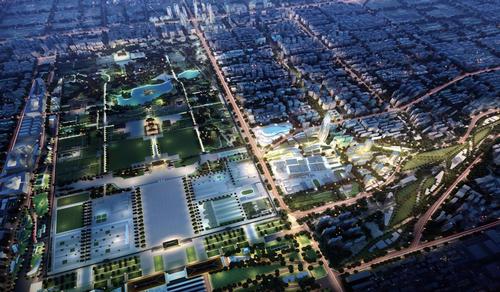23 Mar 2015
Silk Road Museum forms part of regeneration plans for UNESCO World Heritage site in Xi’an China
BY Katie Buckley

London-based Office for Architectural Cultural (OAC) has revealed the competition winning design for the UNESCO World Heritage site at Daming Palace in Xi’an, China. The scheme will be an all-encompassing urban regeneration.
Xi’an is home to several UNESCO world heritage sites, and OAC’s mixed-use project will cover part of the Daming Palace Heritage Park, as well as a large early 20th century Dahua Wool Spinning Factory.
Spanning more than 500 hectares (1.9sq m), the first phase of the project will be 580,000sq m (6,243,068sq ft) in size and will include a mixture of developments, including two five-star hotels, culture-themed retail, galleries, offices, live-work studios, apartments and public open spaces.
Steeped in Chinese history, the Daming Palace was the imperial palace complex for the Chinese Tang Dynasty (617 – 907 AD) and is the largest of its kind in history. Thirteen other Chinese Dynasties also occupied the site from 221 BC.
In order to showcase the site's unique heritage, a 12,000sq m (129,000sq ft) Silk Road Museum has been proposed as part of the development. Sitting inside the Daming Palace Heritage Park, OAC envisages the museum will "form a centre and platform for cultural exchange across Eurasian continents." The site will also be used to hold bi-annual global expo events showcasing cultures and art.
In an exclusive interview with CLAD, the OAC’s regeneration director, Charles Phu, said a focus on people was a key element for the design of the entire site: “While aiming to bring the site’s already world-famous status to the next level, I believe it's even more important to encourage people to interact and enjoy a socially and culturally sustainable, human-friendly urban environment, by breaking down the scale of buildings and spaces and providing freedom of movement to pedestrians,’’ he said.
Continuing with the people focus Phu added: “In order to construct something, you sometimes need to break the rules and challenge trends. It's not only about the grand vision; it's about human wellbeing. It's more than a design or urban issue; it's a social and human issue’’.
Many of the buildings in the masterplan retain early settlement patterns. A modern, eco-friendly, 300m (984ft) tower will provide space for apartments and offices, with space for the public at its base. The design harks back to the tradition of beacons being used to help way-finding along the Silk Road. The tower will also have an observation deck and a series of sky gardens.
Phu said the OAC’s design is aimed towards public use: “People, not vehicles, should be the master of the place where they live, work and play. Our aim is to counteract the widespread trend of urban developments which are dominated by cars.”
No timescale or budget have yet been announced for the project, however, Phu said designs are being "developed at full steam”.
Close Window